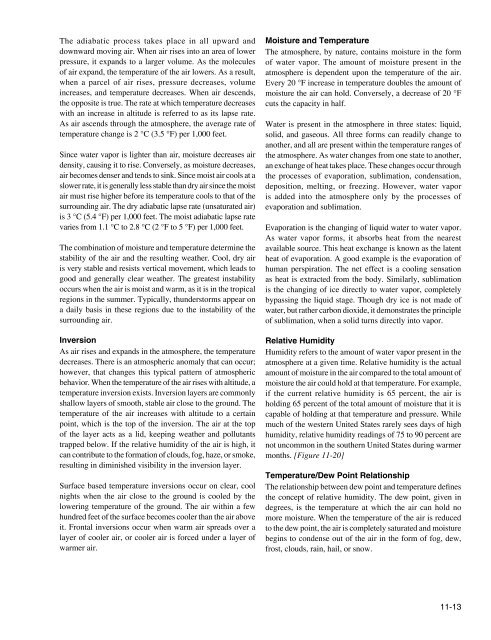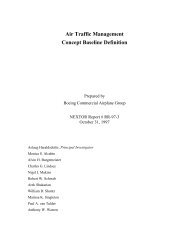Chapter 11: Weather Theory - FAA
Chapter 11: Weather Theory - FAA
Chapter 11: Weather Theory - FAA
Create successful ePaper yourself
Turn your PDF publications into a flip-book with our unique Google optimized e-Paper software.
The adiabatic process takes place in all upward anddownward moving air. When air rises into an area of lowerpressure, it expands to a larger volume. As the moleculesof air expand, the temperature of the air lowers. As a result,when a parcel of air rises, pressure decreases, volumeincreases, and temperature decreases. When air descends,the opposite is true. The rate at which temperature decreaseswith an increase in altitude is referred to as its lapse rate.As air ascends through the atmosphere, the average rate oftemperature change is 2 °C (3.5 °F) per 1,000 feet.Since water vapor is lighter than air, moisture decreases airdensity, causing it to rise. Conversely, as moisture decreases,air becomes denser and tends to sink. Since moist air cools at aslower rate, it is generally less stable than dry air since the moistair must rise higher before its temperature cools to that of thesurrounding air. The dry adiabatic lapse rate (unsaturated air)is 3 °C (5.4 °F) per 1,000 feet. The moist adiabatic lapse ratevaries from 1.1 °C to 2.8 °C (2 °F to 5 °F) per 1,000 feet.The combination of moisture and temperature determine thestability of the air and the resulting weather. Cool, dry airis very stable and resists vertical movement, which leads togood and generally clear weather. The greatest instabilityoccurs when the air is moist and warm, as it is in the tropicalregions in the summer. Typically, thunderstorms appear ona daily basis in these regions due to the instability of thesurrounding air.InversionAs air rises and expands in the atmosphere, the temperaturedecreases. There is an atmospheric anomaly that can occur;however, that changes this typical pattern of atmosphericbehavior. When the temperature of the air rises with altitude, atemperature inversion exists. Inversion layers are commonlyshallow layers of smooth, stable air close to the ground. Thetemperature of the air increases with altitude to a certainpoint, which is the top of the inversion. The air at the topof the layer acts as a lid, keeping weather and pollutantstrapped below. If the relative humidity of the air is high, itcan contribute to the formation of clouds, fog, haze, or smoke,resulting in diminished visibility in the inversion layer.Surface based temperature inversions occur on clear, coolnights when the air close to the ground is cooled by thelowering temperature of the ground. The air within a fewhundred feet of the surface becomes cooler than the air aboveit. Frontal inversions occur when warm air spreads over alayer of cooler air, or cooler air is forced under a layer ofwarmer air.Moisture and TemperatureThe atmosphere, by nature, contains moisture in the formof water vapor. The amount of moisture present in theatmosphere is dependent upon the temperature of the air.Every 20 °F increase in temperature doubles the amount ofmoisture the air can hold. Conversely, a decrease of 20 °Fcuts the capacity in half.Water is present in the atmosphere in three states: liquid,solid, and gaseous. All three forms can readily change toanother, and all are present within the temperature ranges ofthe atmosphere. As water changes from one state to another,an exchange of heat takes place. These changes occur throughthe processes of evaporation, sublimation, condensation,deposition, melting, or freezing. However, water vaporis added into the atmosphere only by the processes ofevaporation and sublimation.Evaporation is the changing of liquid water to water vapor.As water vapor forms, it absorbs heat from the nearestavailable source. This heat exchange is known as the latentheat of evaporation. A good example is the evaporation ofhuman perspiration. The net effect is a cooling sensationas heat is extracted from the body. Similarly, sublimationis the changing of ice directly to water vapor, completelybypassing the liquid stage. Though dry ice is not made ofwater, but rather carbon dioxide, it demonstrates the principleof sublimation, when a solid turns directly into vapor.Relative HumidityHumidity refers to the amount of water vapor present in theatmosphere at a given time. Relative humidity is the actualamount of moisture in the air compared to the total amount ofmoisture the air could hold at that temperature. For example,if the current relative humidity is 65 percent, the air isholding 65 percent of the total amount of moisture that it iscapable of holding at that temperature and pressure. Whilemuch of the western United States rarely sees days of highhumidity, relative humidity readings of 75 to 90 percent arenot uncommon in the southern United States during warmermonths. [Figure <strong>11</strong>-20]Temperature/Dew Point RelationshipThe relationship between dew point and temperature definesthe concept of relative humidity. The dew point, given indegrees, is the temperature at which the air can hold nomore moisture. When the temperature of the air is reducedto the dew point, the air is completely saturated and moisturebegins to condense out of the air in the form of fog, dew,frost, clouds, rain, hail, or snow.<strong>11</strong>-13
















